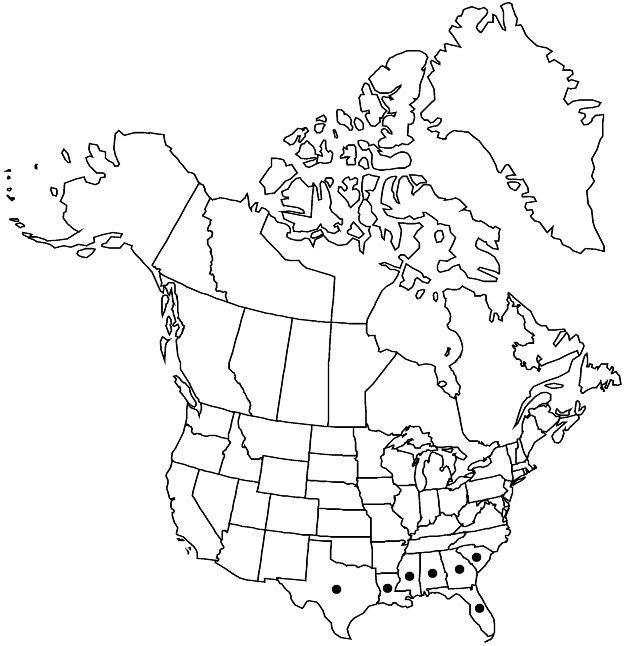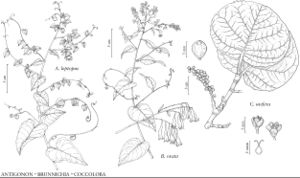Difference between revisions of "Antigonon leptopus"
Bot. Beechy Voy., 308, plate 69. 1838.
FNA>Volume Importer |
imported>Volume Importer |
||
| (3 intermediate revisions by 2 users not shown) | |||
| Line 8: | Line 8: | ||
}} | }} | ||
|common_names=Mountain-rose coralvine;queen’s-jewels | |common_names=Mountain-rose coralvine;queen’s-jewels | ||
| + | |special_status={{Treatment/ID/Special_status | ||
| + | |code=I | ||
| + | |label=Introduced | ||
| + | }}{{Treatment/ID/Special_status | ||
| + | |code=F | ||
| + | |label=Illustrated | ||
| + | }} | ||
|basionyms= | |basionyms= | ||
|synonyms= | |synonyms= | ||
| Line 24: | Line 31: | ||
|elevation=0-600 m | |elevation=0-600 m | ||
|distribution=Ala.;Fla.;Ga.;La.;Miss.;S.C.;Tex.;Mexico;Central America;introduced in West Indies;Asia;Africa. | |distribution=Ala.;Fla.;Ga.;La.;Miss.;S.C.;Tex.;Mexico;Central America;introduced in West Indies;Asia;Africa. | ||
| + | |introduced=true | ||
|discussion=<p><i>Antigonon leptopus</i> is cultivated widely as an ornamental in warmer parts of the world and is grown extensively in South America. In the flora region, it appears to have naturalized only in Florida and southern Texas; records from elsewhere probably represent plants that have persisted from cultivation. It propagates easily by cuttings and seeds, and the tubers are edible.</p> | |discussion=<p><i>Antigonon leptopus</i> is cultivated widely as an ornamental in warmer parts of the world and is grown extensively in South America. In the flora region, it appears to have naturalized only in Florida and southern Texas; records from elsewhere probably represent plants that have persisted from cultivation. It propagates easily by cuttings and seeds, and the tubers are edible.</p> | ||
|tables= | |tables= | ||
| Line 33: | Line 41: | ||
-->{{#Taxon: | -->{{#Taxon: | ||
name=Antigonon leptopus | name=Antigonon leptopus | ||
| − | |||
|authority=Hooker & Arnott | |authority=Hooker & Arnott | ||
|rank=species | |rank=species | ||
| Line 48: | Line 55: | ||
|publication title=Bot. Beechy Voy., | |publication title=Bot. Beechy Voy., | ||
|publication year=1838 | |publication year=1838 | ||
| − | |special status= | + | |special status=Introduced;Illustrated |
| − | |source xml=https:// | + | |source xml=https://bitbucket.org/aafc-mbb/fna-data-curation/src/2e0870ddd59836b60bcf96646a41e87ea5a5943a/coarse_grained_fna_xml/V5/V5_1005.xml |
|subfamily=Polygonaceae subfam. Polygonoideae | |subfamily=Polygonaceae subfam. Polygonoideae | ||
|genus=Antigonon | |genus=Antigonon | ||
Latest revision as of 22:07, 5 November 2020
Plants herbaceous or base sometimes woody. Stems climbing or sprawling by tendrils, branched, angular, to 15 m, sparsely to densely brownish- or reddish-pubescent or glabrous. Leaves: ocrea 0.2–2 mm; petiole often winged distally, 1–2.5(–5) cm, glabrate or pubescent; blade 5–14 × (2–)4–10 cm, base usually cordate, margins ciliate, apex acute to acuminate, glabrous or pubescent, especially on veins. Inflorescences 4–20 cm, axes puberulent to pilose; peduncle angular, 1–5 cm, puberulent to pilose. Pedicels articulated proximally, 3–5(–10) mm, glabrous or pubescent. Flowers: tepals ovate to elliptic, 4–8 × 2–6 mm, 8–20 × 4–15 mm in fruit, margins entire, apex acute. Achenes 8–12 × 4–7 mm, shiny. 2n = 14, 40, 42–44, 48.
Phenology: Flowering year-round.
Habitat: Cultivated and often persisting after abandonment, rarely escaping
Elevation: 0-600 m
Distribution

Introduced; Ala., Fla., Ga., La., Miss., S.C., Tex., Mexico, Central America, introduced in West Indies, Asia, Africa.
Discussion
Antigonon leptopus is cultivated widely as an ornamental in warmer parts of the world and is grown extensively in South America. In the flora region, it appears to have naturalized only in Florida and southern Texas; records from elsewhere probably represent plants that have persisted from cultivation. It propagates easily by cuttings and seeds, and the tubers are edible.
Selected References
None.
